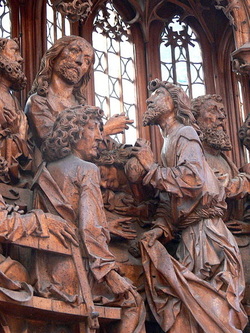Materiality and Production
Tilman Riemenschneider was known for sculpting limewood and other materials in a way that reflected his close attention to detail. The process of carving he used allowed him to render expressions, wrinkles, drapery, and other details that was different from any other sculptor during his time. His characters were usually left with a simple expression, making them look deep in thought. Clothing and drapery were painstakingly rendered down to every last fold and crease. Heads and hands were often done in a set standard that could easily be recognized as a Riemenschneider sculpture. Riemenschneider worked the heads and hands of his figures similarly, rendering them in plain looking way. His sculptures were so recognizable due to the basis of his workshop. They mass produced objects such as angels and crucifixes, but also series of unique retables. Having a set standard made a steady flow of mass production easier to handle (Baxandall, “Tilman Riemenschneider of Wurzburg”, 185).
One element that set Riemenschneider apart from other sculptors during the Renaissance was using his own technique for figure placement within his pieces (Baxandall, “Tilman Riemenschneider of Wurzburg”, 186-187). He had an amazing talent of manipulating light, and used that to place certain characters within each piece. Integrating light as a tool to accentuate his work, tells part of the story that the figures alone cannot do. During different parts of the day, the light coming through the windows of the church and the Holy Blood Altarpiece itself, casts shadows on different figures. Certain heads within the altarpiece are turned so they will always be cast in shadow or in light. This makes central figures clearly more important than others that have been rendered. The way Judas Iscariot is posed for example will always be lit up, being the center of attention and forever focusing on his betrayal of Christ.
Another detail that put Tilman Riemenschneider in a different category than that of other Renaissance sculptors was his tendency towards simplicity. Many artists during the Renaissance time period were leaning towards a Classical style, which portrayed characters that were overly emotional. Riemenschneider’s figures often exuberate an inner emotion that was expressed through simple facial expressions (Art Experts Web).
Riemenschneider’s use of light and simplistic expression has made him stand out from other works even today. He was known as one of the most famous sculptors between the Gothic and Renaissance time periods. Using his own style and technique has made many people consider Reimenschneider to be one of the most well-known and well-loved sculptors in all of German history.
“Tilman Riemenschneider” Art Experts Website. http://www.artexpertswebsite.com/pages/artists/riemenschneider.php
Baxandall, “Tilman Riemenschneider of Wurzburg”, 185.
Justus Bier, “Tilman Riemenschneider: His Life and Work,” 63.
One element that set Riemenschneider apart from other sculptors during the Renaissance was using his own technique for figure placement within his pieces (Baxandall, “Tilman Riemenschneider of Wurzburg”, 186-187). He had an amazing talent of manipulating light, and used that to place certain characters within each piece. Integrating light as a tool to accentuate his work, tells part of the story that the figures alone cannot do. During different parts of the day, the light coming through the windows of the church and the Holy Blood Altarpiece itself, casts shadows on different figures. Certain heads within the altarpiece are turned so they will always be cast in shadow or in light. This makes central figures clearly more important than others that have been rendered. The way Judas Iscariot is posed for example will always be lit up, being the center of attention and forever focusing on his betrayal of Christ.
Another detail that put Tilman Riemenschneider in a different category than that of other Renaissance sculptors was his tendency towards simplicity. Many artists during the Renaissance time period were leaning towards a Classical style, which portrayed characters that were overly emotional. Riemenschneider’s figures often exuberate an inner emotion that was expressed through simple facial expressions (Art Experts Web).
Riemenschneider’s use of light and simplistic expression has made him stand out from other works even today. He was known as one of the most famous sculptors between the Gothic and Renaissance time periods. Using his own style and technique has made many people consider Reimenschneider to be one of the most well-known and well-loved sculptors in all of German history.
“Tilman Riemenschneider” Art Experts Website. http://www.artexpertswebsite.com/pages/artists/riemenschneider.php
Baxandall, “Tilman Riemenschneider of Wurzburg”, 185.
Justus Bier, “Tilman Riemenschneider: His Life and Work,” 63.
Page created by Rachel Echelbarger, Northern Renaissance Art, May 2011

